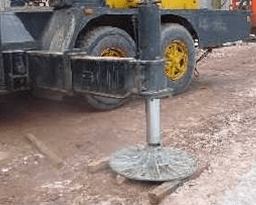Common Reasons for Crane Accidents

Keeping Productive When The Ministry Inspector Arrives
It’s a good day. The sun is out and, even if the job is running a bit behind schedule, you’re sure that you can get it back on track.
Then you see the blue hat and you’re not so sure. The Ministry of Labour is on site and everyone’s on their best behavior trying not to be noticed.
Is everything covered? Is a Stop Work order going to put you even further behind?
The operator of the this crane (see picture right) was asked to improve the outrigger blocking. His next set up looked like this. In addition to the poor blocking, the tires are on the ground.
Don’t let your crane hold up the project. Here’s a checklist to help ensure your crane operations satisfy the Construction Regulations so you can turn the inspector away with a smile.
Keep A Log
Probably the first thing the inspector will ask for will be the crane log book. You are required to keep a log of all tests, inspections, maintenance, and modifications to the crane. The log book must stay in the crane and has to cover at least one the last year and in any case for as long as the crane has been on the same project. Older logs can be kept in a permanent file at the office. If your company does not their own log format, you can get typical log books from Construction Safety Association of Ontario.
Conduct Regular Inspections
The wire rope has to be inspected once per week and its condition is to be documented in the log book. Also, the entire crane is to be inspected at least annually or as often as required by the manufacturer. This inspection must cover all aspects of the crane including all mechanical and structural elements.
Use Rated Rigging Gear Only
Lifting frames, beams, buckets, pallet forks, coil hooks, etc. all have to be load rated with a factor of safety of five. If you’ve got unrated lifting equipment – replace it, or have an engineer load rate it.
Catalogue Hook Blocks & Balls
Hook blocks have to have their weight and load rating labelled on them. Very often, the tags fall off, and the owner is left trying to remember what it said. By cataloguing the manufacturer, serial number, model, weight, and load rating, a new plate can be ordered from the manufacturer economically. The alternative is to have a rep from a block manufacturer examine it and give you a rating; usually at the cost of thousands of dollars.
When Using Manbaskets…
A number of requirements come up once a manbasket is attached to a crane. Make sure that:
- The platform has been load rated by a professional engineer and that the design drawings were reviewed and sealed by the engineer. The load rating must be labelled on the platform as well.
- The crane has been inspected by a professional engineer (or someone designated by him/her) using nondestructive testing methods within the last twelve months.
- Modified load charts specifically for manbasket use have been prepared by a professional engineer and are in the crane.
- An emergency rescue procedure has been developed and communicated in writing to all workers involved in the operation.
- All documentation including platform drawings, engineering certificates, procedures, load charts, etc. is kept with the crane.
Of course, there are many operational procedures that must also be adhered to such as using proper signalling or attaching tag lines. However, ensuring that the above steps are carried out and that all the paperwork is maintained in a permanent file is a big part of carrying out your due diligence.




